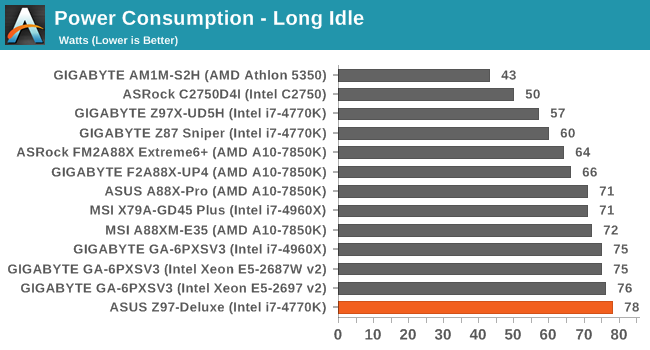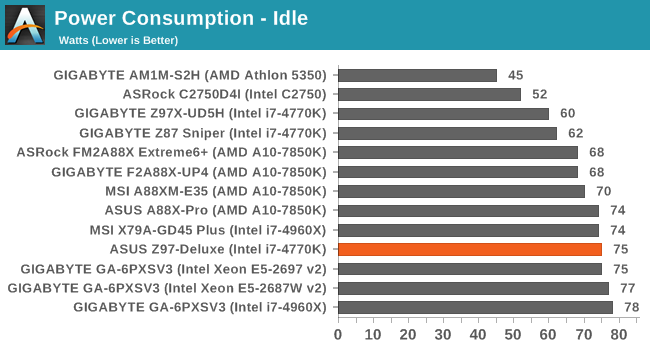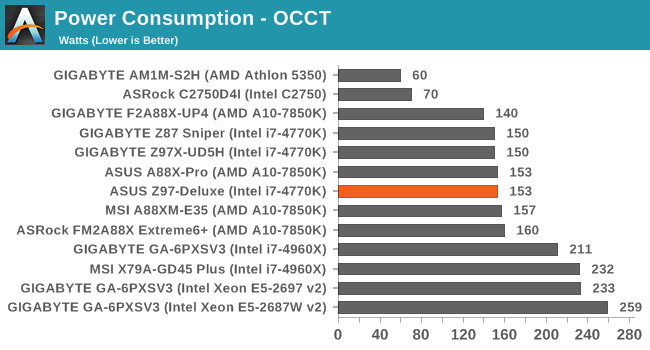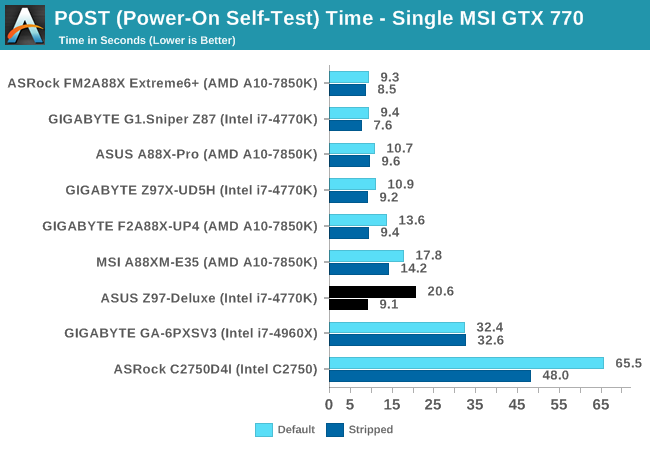ASUS Z97-DELUXE (NFC & WLC) Review: With Two Thunderbolt 2 Too
by Ian Cutress on May 16, 2014 11:00 AM EST- Posted in
- Motherboards
- Intel
- Asus
- NFC
- 802.11ac
- Thunderbolt 2
- Z97
- Wireless Charging
Many thanks to...
We must thank the following companies for kindly providing hardware for our test bed:
- Thank you to OCZ for providing us with PSUs and SSDs.
- Thank you to G.Skill for providing us with memory kits.
- Thank you to Corsair for providing us with an AX1200i PSU, Corsair H80i CLC and DRAM.
- Thank you to ASUS for providing us with the AMD HD7970 GPUs and some IO Testing kit.
- Thank you to MSI for providing us with the NVIDIA GTX 770 Lightning GPUs.
- Thank you to Rosewill for providing us with PSUs and RK-9100 keyboards.
Test Setup
| Test Setup | |
| Processor |
Intel Core i7-4770K ES 4 Cores, 8 Threads, 3.5 GHz (3.9 GHz Turbo) |
| Motherboard | ASUS Z97-Deluxe (NFC + WLC) |
| Cooling |
Corsair H80i Thermalright TRUE Copper |
| Power Supply |
OCZ 1250W Gold ZX Series Corsair AX1200i Platinum PSU |
| Memory | G.Skill RipjawsZ 4x4 GB DDR3-1600 9-11-9 Kit |
| Memory Settings | 1600 9-11-9-27 1T tRFC 240 |
| Video Cards |
MSI GTX 770 Lightning 2GB (1150/1202 Boost) ASUS HD7970 3GB (Reference) |
| Video Drivers |
Catalyst 13.12 NVIDIA Drivers 335.23 |
| Hard Drive | OCZ Vertex 3 256GB |
| Optical Drive | LG GH22NS50 |
| Case | Open Test Bed |
| Operating System | Windows 7 64-bit SP1 |
| USB 2/3 Testing | OCZ Vertex 3 240GB with SATA->USB Adaptor |
Power Consumption
Power consumption was tested on the system as a whole with a wall meter connected to the OCZ 1250W power supply, while in a single MSI GTX 770 Lightning GPU configuration. This power supply is Gold rated, and as I am in the UK on a 230-240 V supply, leads to ~75% efficiency > 50W, and 90%+ efficiency at 250W, which is suitable for both idle and multi-GPU loading. This method of power reading allows us to compare the power management of the UEFI and the board to supply components with power under load, and includes typical PSU losses due to efficiency. These are the real world values that consumers may expect from a typical system (minus the monitor) using this motherboard.
While this method for power measurement may not be ideal, and you feel these numbers are not representative due to the high wattage power supply being used (we use the same PSU to remain consistent over a series of reviews, and the fact that some boards on our test bed get tested with three or four high powered GPUs), the important point to take away is the relationship between the numbers. These boards are all under the same conditions, and thus the differences between them should be easy to spot.



Power consumption while at idle and long idle seems relatively high, especially compared to the UD5H and another one of the boards we have tested but not published yet. The load power consumption however is lower, suggesting that perhaps there are a few features on the Z97-Deluxe that consume power at idle.
Windows 7 POST Time
Different motherboards have different POST sequences before an operating system is initialized. A lot of this is dependent on the board itself, and POST boot time is determined by the controllers on board (and the sequence of how those extras are organized). As part of our testing, we are now going to look at the POST Boot Time - this is the time from pressing the ON button on the computer to when Windows 7 starts loading. (We discount Windows loading as it is highly variable given Windows specific features.) These results are subject to human error, so please allow +/- 1 second in these results.

One of the big features out of the Z97 motherboards we have tested so far is the long POST times when left at default (the UD5H that formed the basis of our first Z97 review was the exception). However when stripped of controllers, the Z97-Deluxe nudges a nine-second POST time.










45 Comments
View All Comments
Tchamber - Monday, May 19, 2014 - link
Asus have come a long way since my last Asus board... for my old Pentium 4 CPU. This looks good, I want to upgrade when SATA Express becomes mainstream. I should think all us Star Wars fans would love this board/chipset!prophet001 - Monday, May 19, 2014 - link
Did you try booting the XP941 with this motherboard? Would love to see a Windows installation boot on it and get some benchmarks out.RamCity - Monday, May 19, 2014 - link
We just got some feedback from a customer this morning who has installed the XP941 in the ASUS Z97-Deluxe. These are the results with the latest bios dated 16th May (0901)1. With UEFI mode enabled, it's possible to begin a Windows 8 installation from DVD, but on the first reboot, the XP941 drive is not recognised, so the install couldn't proceed.
2. Customer was able to use the XP941 as storage once Windows 8 was installed to a different drive, but it doesn't show up in the list of bootable devices in the bios. He hasn't yet benchmarked the drive to see what sort of transfer speeds he can get out of it.
3. With the previous version bios, he couldn't even begin the windows installation, so it seems ASUS are working on this. Feedback we have from ASUS HQ in Europe is that they are working on getting the XP941 to boot in legacy mode.
4. The customer actually bought an ASRock Z97 Extreme6 as well and had no issues booting and installing Windows on the XP941 (installed in the M.2 socket), and confirmed it operated at full 1200/950MB/s transfer speeds.
My feeling is that it's only a matter of time before ASUS has a bios update which will allow the XP941 to have the OS installed and be bootable, but at this point it's not possible (at least from one customers point of view, and he seemed very technically astute)
Rod (vendor rep for ramcity.com.au)
prophet001 - Tuesday, May 20, 2014 - link
Thank you for the reply. Sounds exciting. Surely the floodgates are about to be opened on this technology.Timur Born - Tuesday, June 10, 2014 - link
How does audio sound once connected to speaker with 3-prong (earth line) speaker system? Like the ones that really would benefit from the audio specs written on paper, not the cheapish 2-prong desktop speaker systems.It's troubling how hard it is to find a modern mainboard that does not amplify all kinds of electronic noise (voltage) over its ground lines (anything made of metal metal), which affects both internal and external audio (PCIe, USB, FW). This is not really a ground-loop issue, but one of noisy ground lines on motherboards (while the PSU and interestingly SATA port ground remains rather clean/unamplified).